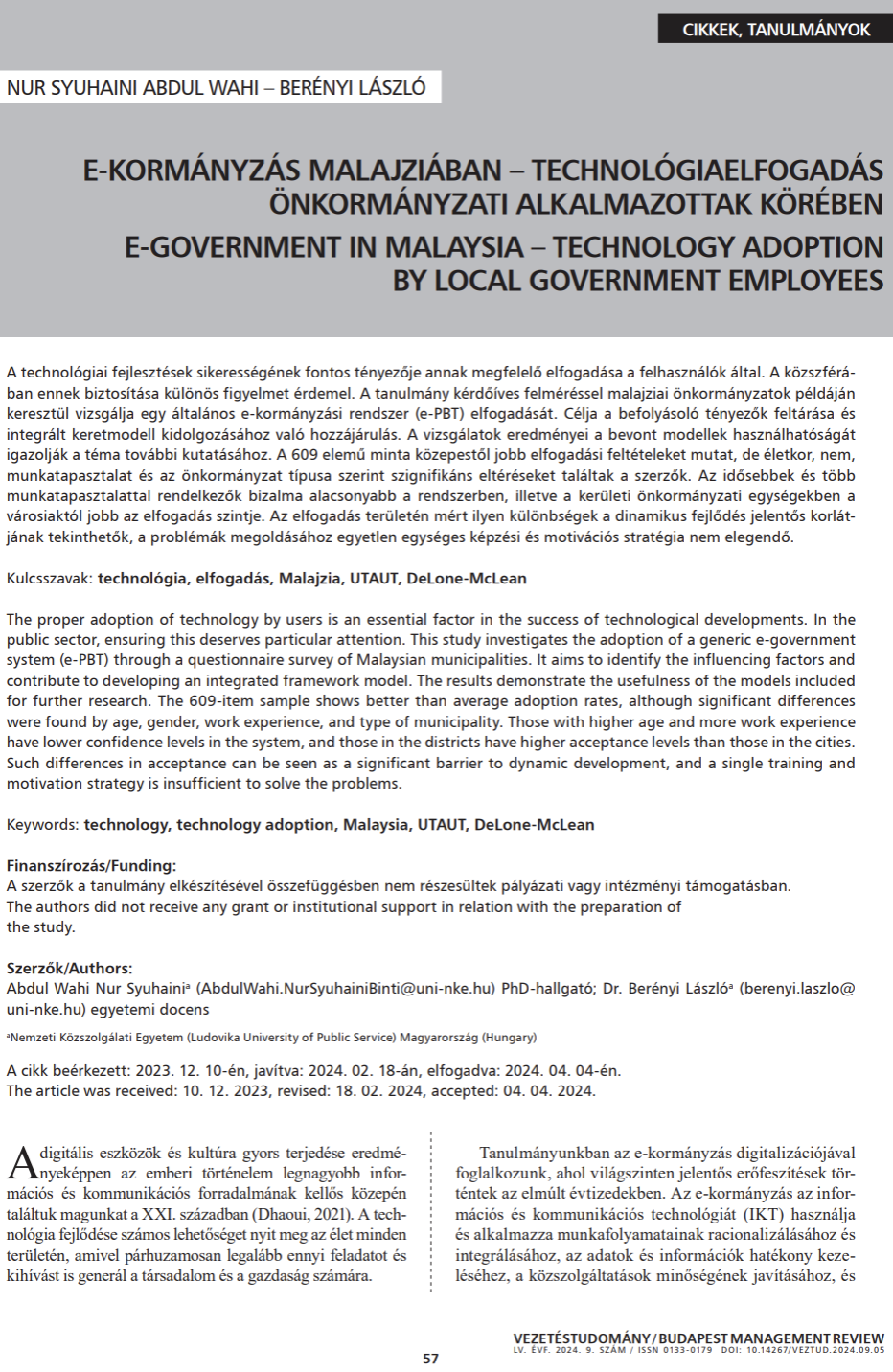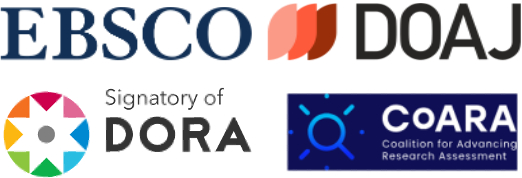E-kormányzás Malajziában
Technológiaelfogadás önkormányzati alkalmazottak körében
DOI:
https://doi.org/10.14267/VEZTUD.2024.09.05Kulcsszavak:
technológia, elfogadás, Malajzia, UTAUT, DeLone-McLeanAbsztrakt
A technológiai fejlesztések sikerességének fontos tényezője annak megfelelő elfogadása a felhasználók által. A közszférában ennek biztosítása különös figyelmet érdemel. A tanulmány kérdőíves felméréssel malajziai önkormányzatok példáján keresztül vizsgálja egy általános e-kormányzási rendszer (e-PBT) elfogadását. Célja a befolyásoló tényezők feltárása és integrált keretmodell kidolgozásához való hozzájárulás. A vizsgálatok eredményei a bevont modellek használhatóságát igazolják a téma további kutatásához. A 609 elemű minta közepestől jobb elfogadási feltételeket mutat, de életkor, nem, munkatapasztalat és az önkormányzat típusa szerint szignifikáns eltéréseket találtak a szerzők. Az idősebbek és több munkatapasztalattal rendelkezők bizalma alacsonyabb a rendszerben, illetve a kerületi önkormányzati egységekben a városiaktól jobb az elfogadás szintje. Az elfogadás területén mért ilyen különbségek a dinamikus fejlődés jelentős korlátjának tekinthetők, a problémák megoldásához egyetlen egységes képzési és motivációs stratégia nem elegendő.
Letöltések
Hivatkozások
Abdul Wahi, N.S., & Berenyi, L. (2023). Systematic Literature Review on Adoption of E-government among Employees in the Public Sector. CEEeGov ’23: Proceedings of the Central and Eastern European eDem and eGov Days 2023, 21–28. https://doi.org/10.1145/3603304.3603336
Abdullah, N.R.W., Mansor, N.B., & Hamzah, A. (2013). Keeping ahead of the game: Innovations and challenges in e-government in Malaysia. Economic and Labour Relations Review, 24(4), 549–567. https://doi.org/10.1177/1035304613508868
Al-Swidi, A.K., & Faaeq, M.K. (2019). How robust is the UTAUT theory in explaining the usage intention of e-government services in an unstable security context? A study in Iraq. Electronic Government, 15(1), 37–66. https://doi.org/10.1504/EG.2019.096580
Alibraheem, M.H., Abdul-Jabbar, H., & Ibrahim, I. (2019). Electronic tax filing adoption in Jordan: The tax employees’ perspectives. International Journal of Advanced Science and Technology, 28(17), 681–689. https://www.researchgate.net/publication/338293178_ELECTRONIC_TAX_FILING_ADOPTION_IN_JORDAN_THE_TAX_EMPLOYEES’_PERSPECTIVES
Alraja, M.N., Hammami, S., Chikhi, B., & Fekir, S. (2016). The influence of effort and performance expectancy on employees to adopt E-government: Evidence from Oman. International Review of Management and Marketing, 6(4), 930–934. https://dergipark.org.tr/tr/download/article-file/367428
Apleni, A., & Smuts, H. (2020). An e-government implementation framework: A developing country case study. In Responsible Design, Implementation and Use of Information and Communication Technology 19th IFIP WG 6.11 Conference on e-Business, e-Services, and e-Society, I3E 2020, Skukuza, South Africa, April 6–8, 2020, Proceedings, Part II. (pp. 15-27). Springer International Publishing. https://doi.org/10.1007/978-3-030-45002-1_2
Apriliyanti, I.D., Kusumasari, B., Pramusinto, A., & Setianto, W.A. (2021). Digital divide in ASEAN member states: Analyzing the critical factors for successful e-government programs. Online Information Review, 45(2), 440–460. https://doi.org/10.1108/OIR-05-2020-0158
Aranyossy, M. (2018). Citizen adoption of e-government services – Evidence from Hungary. 31st Bled EConference: Digital Transformation: Meeting the Challenges, BLED 2018, May, (pp. 27–46). https://doi.org/10.18690/978-961-286-170-4.3
Aranyossy, M., & ifj. Boross, I. (2018). E-kormányzati siker: Szakirodalmi áttekintés kvantitatív szövegelemzés alapján. Vezetéstudomány, 49(7-8), 6–21. https://doi.org/10.14267/VEZTUD.2018.07–08.02
Azamela, J.C., Tang, Z., Ackah, O., & Awozum, S. (2022). Assessing the Antecedents of E-Government Adoption: A Case of the Ghanaian Public Sector. SAGE Open, 12(2). https://doi.org/10.1177/21582440221101040
Batara, E., Nurmandi, A., Warsito, T., & Pribadi, U. (2017). Are government employees adopting local e-government transformation? The need for having the right attitude, facilitating conditions and performance expectations. Transforming Government: People, Process and Policy, 11(4), 612–638. https://doi.org/https://doi.org/10.1108/TG-09-2017-0056
Berényi, L., Deutsch, N., Pintér, É., Bagó, P., & Nagy- Borsy, V. (2021). Technology Adoption Propensity Among Hungarian Business Students. European Scientific Journal, 17(32), 1–21. https://doi.org/10.19044/esj.2021.v17n32p1
Congo, S., & Choi, S.O. (2022). Evaluating Public Sector Employees’ Adoption of E-Governance and Its Impact on Organizational Performance in Angola. Sustainability, 14(23). https://doi.org/10.3390/su142315605
Dečman, M. (2015). Understanding technology acceptance of government information systems from employees’ perspective. International Journal of Electronic Government Research, 11(4), 69–88. https://doi.org/10.4018/IJEGR.2015100104
DeLone, W.H., & McLean, E.R. (1992). Information systems success: The quest for the dependent variable. Information Systems Research, 3(1), 60–95. https://doi.org/10.1287/isre.3.1.60
DeLone, W.H., & McLean, E.R. (2003). The DeLone and McLean model of information systems success: A tenyear update. Journal of Management Information Systems, 19(4), 9–30. https://doi.org/10.1080/07421222.2003.11045748
Deutsch, N., Hoffer, I., Berényi, L., & Nagy-Borsy, V. (2019). A technológia szerepének stratégiai felértékelődése: Szemelvények a stratégiai technomenedzsment témaköréből. Budapesti Corvinus Egyetem. https://real.mtak.hu/93337/1/Deutsch_Hoffer_konyv.pdf
Dewi, A.A.I.K.G., & Fajar, A.N. (2021). Assessing the success of Kominfo mail handling system based on employee perspective. Journal of Theoretical and Applied Information Technology, 99(11), 2595–2604. https://www.jatit.org/volumes/Vol99No11/8Vol99No11.pdf
Dhaoui, I. (2021). E-Government for Sustainable Development: Evidence from MENA Countries. Journal of the Knowledge Economy, 13, 2070–2099. https://doi.org/10.1007/s13132-021-00791-0
Dukić, D., Dukić, G., & Bertović, N. (2016). Public administration employees’ readiness and acceptance of e-government: Findings from a Croatian survey. Information Development, 33(5), 525–539. https://doi.org/10.1177/0266666916671773
Economic Planning Unit (2020). (2022) Malaysia. Unit Perancang Ekonomi / Economic Planning Unit. Malaysia. https://www.loc.gov/item/lcwaN0038596/
ENSZ (2020). UN E-Government Survey 2020. https://publicadministration.un.org/egovkb/en-us/Reports/UN-E-Government-Survey-2020
Economic Plannig Unit (2021). Malaysia Digital Economy Blueprint. https://www.ekonomi.gov.my/sites/default/files/2021-02/malaysia-digital-economy-blueprint.pdf
Furuholt, B., & Wahid, F. (2008). E-government challenges and the role of political leadership in Indonesia: The case of Sragen. Proceedings of the Annual Hawaii International Conference on System Sciences, 1–10. https://doi.org/10.1109/HICSS.2008.134
Gholami, R., Singh, N., Agrawal, P., Espinosa, K., & Bamufleh, D. (2021). Information technology/systems adoption in the public sector: Evidence from the Illinois Department of Transportation. Journal of Global Information Management, 29(4), 172–194. https://doi.org/10.4018/JGIM.20210701.oa8
Hair, J., Black, W., & Babin, B. (2010). Multivariate Data Analysis. Prentice-Hall.
Hamid, A.A., Razak, F.Z.A., Bakar, A.A., & Abdullah, W.S.W. (2016). The Effects of Perceived Usefulness and Perceived Ease of Use on Continuance Intention to Use E-Government. Procedia Economics and Finance, 35(October), 644–649. https://doi.org/10.1016/s2212-5671(16)00079-4
Hazam, S.R.T., Mansor, N., & Bahari, A. (2019). Integrated reporting and ePBT system implementation in Malaysia local authorities. International Journal of Accounting, 4(22), 90–100. http://www.ijafb.com/PDF/IJAFB-2019-22-09-06.pdf
Heeks, R. (2003). Most e-government for development projects fail: How can risks be reduced? IGovernment Working Paper Series, Institute for Development Policy and Management. 1–19.
Ibrahim, O.A., & Zakaria, N.H. (2016). E-government services in developing countries: A success adoption model from employees perspective. Journal of Theoretical and Applied Information Technology, 94(2), 383–396. https://seminar.utmspace.edu.my/Jisri/download/vol8/88.pdf
IMD (2023). IMD World Competitveness Booklet. https://imd.cld.bz/IMD-World-Competitiveness-Booklet-2023
Isaias, P., & Issa, T. (2015). High Level Models and Methodologies for Information Systems. Springer.
Jackson, J.D., Yi, M.Y., & Park, J.S. (2013). An empirical test of three mediation models for the relationship between personal innovativeness and user acceptance of technology. Information and Management, 50(4), 154–161. https://doi.org/10.1016/j.im.2013.02.006
Jin, J.L.Y., & Amin, A. (2020). A Preliminary Study on the Factors Affecting the Adoption of E-Government Services by Malaysians. In 2020 International Conference on Computational Intelligence, ICCI 2020 (pp. 80–85). https://doi.org/10.1109/ICCI51257.2020.9247752
Kamarudin, S., Omar, S.Z., Zaremohzzabieh, Z., Bolong, J., & Osman, M.N. (2021). Factors predicting the adoption of e-government services in telecenters in rural areas: The mediating role of trust. Asia-Pacific Social Science Review, 21(1), 20–38. https://animorepository.dlsu.edu.ph/apssr/vol21/iss1/3/
Keszey T., & Zsukk, J. (2017). Az új technológiák fogyasztói elfogadása. A magyar és nemzetközi szakirodalom áttekintése és kritikai értékelése. Vezetéstudomány, 48(10), 38–47. https://doi.org/10.14267/VEZTUD.2017.10.05
Khan, F., Khan, S., & Zhang, B. (2010). E-government challenges in developing countries: A case study of Pakistan. Proceedings – 2010 International Conference on Management of e-Commerce and e-Government, ICMeCG 2010 (pp. 200–203). https://doi.org/10.1109/ICMeCG.2010.49
Lean, O.K., Zailani, S., Ramayah, T., & Fernando, Y. (2009). Factors influencing intention to use e-government services among citizens in Malaysia. International Journal of Information Management, 29(6), 458–475. https://doi.org/10.1016/j.ijinfomgt.2009.03.012
Lněnička, M. (2015). E-Government development index and its comparison in the EU member states. Scientific Papers of the University of Pardubice, Series D: Faculty of Economics and Administration, 22(34), 75–87. Malaysian Administrative Modernisation and Management Planning Unit (2021). https://www.mampu.gov.my/en/about-us/role-of-mampu-department/
Mellouli, M., Bouaziz, F., & Bentahar, O. (2020). E-government success assessment from a public value perspective. International Review of Public Administration, 25(3), 153–174. https://doi.org/10.1080/12294659.2020.1799517
Mhina, J.R.A., Md Johar, M.G., & Alkawaz, M.H. (2019). The Influence of Perceived Confidentiality Risks and Attitude on Tanzania Government Employees’ Intention to Adopt Web 2.0 and Social Media for Work-Related Purposes. International Journal of Public Administration, 42(7), 558–571. https://doi.org/10.1080/01900692.2018.1491596
Mohammed, M., Burhanuddin, M., Ibrahim, H., Ali, M., Jaber, M., & Shawakt, A. (2016). E-government and its challenges in developing countries case study Iraqi E-government. Social Sciences, 11(17), 4310–4319.
Mutula, S.M., & Mostert, J. (2010). Challenges and opportunities of e-government in South Africa. Electronic Library, 28(1), 38–53. https://doi.org/10.1108/02640471011023360
Nemeslaki, A. (2018). A magyar közigazgatás digitá- lis transzformációjának jelentősége a vezetéstudományban. Vezetéstudomány, 49(7-8), 2–5. https://doi.org/10.14267/VEZTUD.2018.07–08.01
Nkwe, N. (2012). E-government: challenges and opportunities in Botswana. International Journal of Humanities and Social Science, 2(17), 39–48. http://www.ijhssnet.com/journals/Vol_2_No_17_September_2012/5.pdf
Olatubosun, O., & Rao, K. S. M. (2012). Empirical study of the readiness of public servants on the adoption of e-government. International Journal of Information Systems and Change Management, 6(1), 17–37. https://doi.org/10.1504/IJISCM.2012.050337
Othman, M.H., & Razali, R. (2018). Whole of Government critical success factors towards integrated e-government services: a preliminary review. Journal Pengurusan, 53, 1–16. https://journalarticle.ukm.my/20401/1/28138-102250-1-PB.pdf
Othman, M.H., Razali, R., & Nasrudin, M. F. (2020). Key factors for e-government towards sustainable development goals. International Journal of Advanced Science and Technology, 29(6 Special Issue), 2864–2876.
Pitchay Muthu Chelliah, P., Thurasamy, R., Alzahrani, A.I., Alfarraj, O., & Alalwan, N. (2016). E-Government service delivery by a local government agency: The case of E-Licensing. Telematics and Informatics, 33(4), 925–935. https://doi.org/10.1016/j.tele.2016.02.003
Ramli, R.M. (2017). E-government implementation challenges in Malaysia and South Korea: A comparative study. Electronic Journal of Information Systems in Developing Countries, 80(1), 1–26. https://doi.org/10.1002/j.1681-4835.2017.tb00591.x
Rosnidah, I., Johari, R.J., Musyaffi, A.M., Marota, R., & Muna, A. (2022). E-Government Finance System Readiness for Village Government Employees: Lessons from Indonesia. Quality – Access to Success, 23(189), 238–244. https://doi.org/10.47750/QAS/23.189.27
Safiah Maznorbalia, A., & Aiman Awalluddin, M. (2021). Users Acceptance of E-Government System in Sintok, Malaysia: Applying the UTAUT Model. Policy & Governance Review, 5(1), 66. https://doi.org/10.30589/pgr.v5i1.348
Samsor, A.M. (2021). Challenges and prospects of e-government implementation in Afghanistan. International Trade, Politics and Development, 5(1), 51–70. https://doi.org/10.1108/itpd-01-2020-0001
Sarrayrih, M.A., & Sriram, B. (2015). Major challenges in developing a successful e-government: A review on the Sultanate of Oman. Journal of King Saud University –Computer and Information Sciences, 27(2), 230–235. https://doi.org/10.1016/j.jksuci.2014.04.004
Seng, W. M., Jackson, S., & Philip, G. (2010). Cultural issues in developing E-government in Malaysia. Behaviour and Information Technology, 29(4), 423– 432. https://doi.org/10.1080/01449290903300931
Shuib, L., Yadegaridehkordi, E., & Ainin, S. (2019). Malaysian urban poor adoption of e-government applications and their satisfaction. Cogent Social Sciences, 5(1), 1–18. https://doi.org/10.1080/23311886.2019.1565293
Silcock, R. (2001). What is e-government? Parliamentary Affairs, 54(1), 88–101. https://doi.org/10.1093/pa/54.1.88
Supramaniam, S., & Singaravelloo, K. (2021). Impact of emotional intelligence on organisational performance: an analysis in the Malaysian public administration. Administrative Sciences, 11(3). https://doi.org/10.3390/ADMSCI11030076
Tabuni, Y., & Kusuma, G.P. (2019). Evaluation of e-government use among civil servants using unified theory of acceptance and use of technology model – a case of central mamberamo regency. International Journal of Scientific and Technology Research, 8(9), 1624–1631. https://www.ijstr.org/final-print/sep2019/Evaluation-Of-E-government-Use-Among-Civil-Servants-Using-Unified-Theory-Of-Acceptance-And-Use-Of-Technology-Model-A-Case-Of-Central-Mamberamo-Regency.pdf
Venkatesh, V., Morris, M.G., Davis, G.B., & Davis, F.D. (2003). User acceptance of information technology: Towards a unified view. MIS Quarterly, 27(3), 425– 478. https://doi.org/10.2307/30036540
Veszelka, T., & Z. Karlavics, L. (1997). Malajzia: Út az információs társadalomba. Kossuth Kiadó.
Virgiyanti, W., Azidin, S.S., Tufail, M.A., & Ahmad, A. (2018). Evaluating the behavioral intention to use e-Government services from Malaysian’s perspective in Kedah state of Malaysia. Journal of Social Sciences Research, (Special Issue 6), 832–838. https://doi.org/10.32861/jssr.spi6.832.838
Zainol, Z., Fernandez, D., & Ahmad, H. (2017). Public Sector Accountants’ Opinion on Impact of a New Enterprise System. Procedia Computer Science, 124, 247–254. https://doi.org/10.1016/j.procs.2017.12.153

Downloads
Megjelent
Hogyan kell idézni
Folyóirat szám
Rovat
License
Copyright (c) 2024 Copyright (c) 2024 Corvinus University of Budapest, publisher of Vezetéstudomány / Budapest Management Review

This work is licensed under a Creative Commons Attribution 4.0 International License.
Authors assign copyright to Vezetéstudomány / Budapest Management Review. Authors are responsible for permission to reproduce copyright material from other sources.

